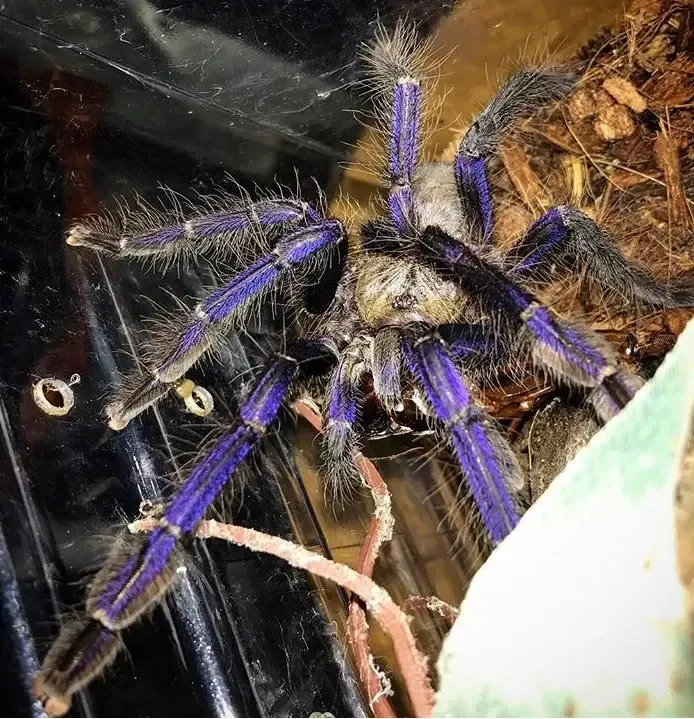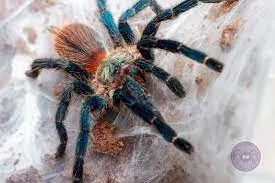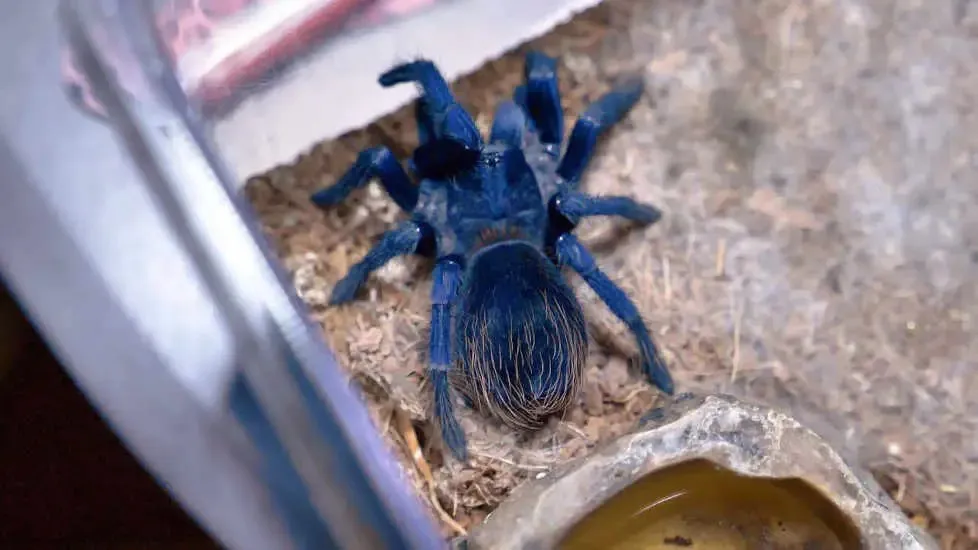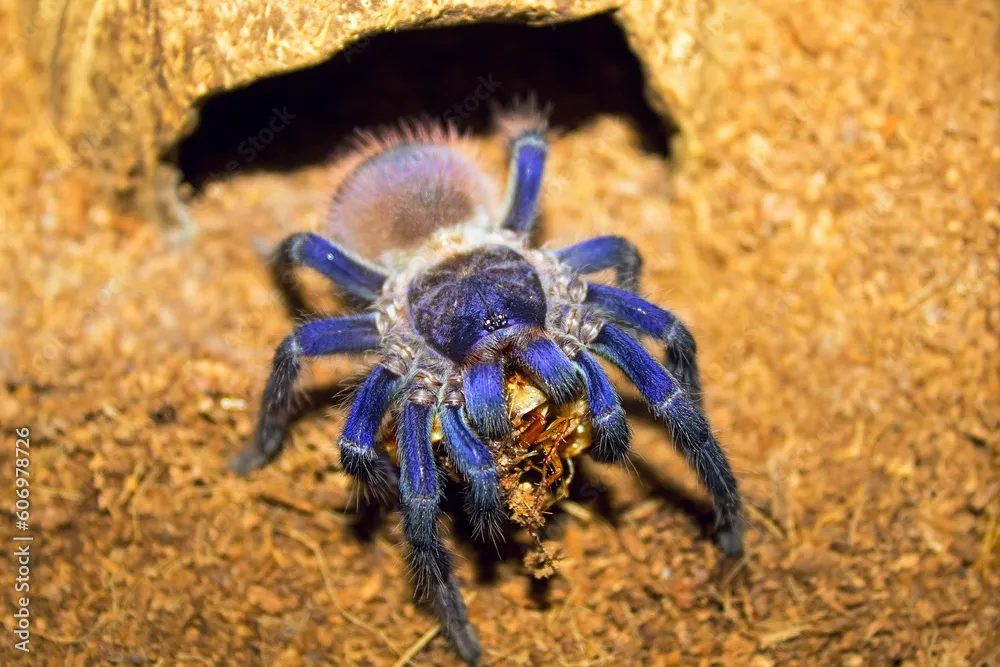Understanding Brazilian Blue Tarantula Feeding
Brazilian Blue Tarantulas (Chromatopelma cyaneopubescens) are captivating creatures, admired for their vibrant blue coloration and relatively docile temperament. As a responsible tarantula owner, understanding their feeding habits is crucial for their health, well-being, and longevity. Feeding a Brazilian Blue Tarantula isn’t just about tossing in a cricket or two; it’s about understanding their natural behaviors, nutritional needs, and potential challenges. These tarantulas are opportunistic feeders, meaning they will eat when food is available. However, it’s essential to provide a balanced diet and a suitable environment to ensure they thrive in captivity. This guide will delve into the essential aspects of feeding your Brazilian Blue Tarantula, offering practical advice and addressing common concerns to help you provide the best possible care for your cherished pet.
Feeding Frequency
Determining the appropriate feeding frequency for your Brazilian Blue Tarantula is vital for its overall health. The frequency depends on the tarantula’s age, size, and metabolism, which is largely influenced by temperature. Spiderlings, or young tarantulas, require more frequent feedings than adults. Typically, spiderlings should be fed every other day or even daily if they readily accept food. As they grow, the feeding frequency can be gradually reduced. Sub-adults and adults can be fed once or twice a week. Observe your tarantula’s abdomen; if it appears plump and round, it indicates it is well-fed. Overfeeding can lead to health issues, so it’s always better to err on the side of caution and provide less food than more. Adjust the frequency based on your tarantula’s appetite and activity levels. Remember, tarantulas can survive for extended periods without food, especially adults, so don’t panic if your pet refuses a meal.
The Importance of Hydration

While feeding is a primary concern, ensuring your Brazilian Blue Tarantula has access to fresh water is equally important. Tarantulas require water for hydration and to aid in the digestion of their meals. Always provide a shallow water dish, such as a bottle cap or a small dish specifically designed for tarantulas. The water dish should be easily accessible and should be kept clean. Regularly check the water dish and refill it with fresh, clean water, at least twice a week. Consider using a syringe to gently drip water onto the substrate near the tarantula’s burrow; this can encourage drinking, especially for newly acquired or stressed spiders. Dehydration can be a significant threat to tarantula health, leading to molting problems and other complications. Therefore, maintaining a proper hydration level is critical for their survival and well-being. Always monitor the humidity levels inside the enclosure. If the humidity is too low, it could cause problems.
Choosing the Right Food
The diet of a Brazilian Blue Tarantula should primarily consist of live insects. Crickets are a common and readily available food source, offering a good source of protein. Other suitable options include mealworms, dubia roaches, and superworms. It’s crucial to vary the diet to provide a range of nutrients. Avoid feeding wild-caught insects, as they may carry parasites or pesticides that can harm your tarantula. Before offering prey, ‘gut-load’ the insects by feeding them nutritious foods such as vegetables, fruits, and commercial insect food. This process ensures that your tarantula receives the maximum nutritional benefit from its meal. Be mindful of the size of the prey; it should be appropriate for the size of your tarantula to avoid any unnecessary risk of injury to the spider during a feeding attempt. The food must be smaller or the same size as the tarantula.
Appropriate Prey Size
Selecting the right size of prey is a key element in successful tarantula feeding. Offering prey that is too large can stress the tarantula and potentially lead to injury if the tarantula cannot subdue the insect quickly. As a general guideline, the prey should be no larger than the size of the tarantula’s abdomen. For spiderlings, it is recommended to use smaller prey, like pinhead crickets or small mealworms. As the tarantula grows, you can gradually increase the size of the prey. Always observe your tarantula’s behavior during feeding. If it seems intimidated by the prey or avoids it altogether, it might be too big. Removing uneaten prey within 24 hours is critical to prevent the insects from harassing or injuring the tarantula. Always check the enclosure after feeding to ensure that all uneaten prey is removed. The size of the prey must be appropriate based on the size of the tarantula.
Observe Your Tarantula’s Appetite

Each tarantula has its own personality and appetite, and understanding your Brazilian Blue Tarantula’s eating habits is essential. Observe its behavior when you offer food. Does it immediately pounce on the prey, or does it show little to no interest? A healthy tarantula should readily accept food. A loss of appetite can be a sign of several factors. A tarantula might refuse food before molting; it is a natural process where they shed their exoskeleton. Don’t worry if the tarantula has a decreased appetite. If the tarantula consistently refuses food, or if there are other signs of illness, such as lethargy or unusual behavior, consult an experienced tarantula keeper or a veterinarian specializing in exotic animals. Never force-feed a tarantula, as this can cause injury and stress. Take note of the tarantula’s feeding patterns over time; it will help you identify when something isn’t right.
Feeding Environment and Safety
Creating a safe and suitable feeding environment is critical to the health and happiness of your Brazilian Blue Tarantula. Always feed your tarantula in its enclosure to avoid stressing it by moving it. Ensure that the enclosure is clean and well-maintained. This will reduce the risk of bacterial infections. Remove any uneaten prey within 24 hours to prevent stress and potential harm to the tarantula. The enclosure should have proper ventilation and a suitable substrate. Make sure the enclosure offers plenty of space for the tarantula to move around. Avoid using any sharp objects or chemicals near the enclosure. Provide hiding places, such as cork bark or artificial plants, to allow the tarantula to feel secure, which can encourage a better feeding response. Maintaining a stable environment will contribute to your tarantula’s feeding habits and overall wellbeing.
Creating the Ideal Feeding Enclosure
The enclosure plays a critical role in encouraging your Brazilian Blue Tarantula to feed. A well-designed enclosure will provide the tarantula with a sense of security, reduce stress, and create an environment that stimulates their natural feeding behaviors. The enclosure should be the appropriate size for the tarantula, allowing enough space for movement and burrowing. The substrate must be several inches deep to allow the tarantula to dig and feel secure. Provide hiding places, such as cork bark, artificial plants, or even a small hideaway. Ensure good ventilation to prevent the build-up of humidity and the growth of mold. Keep the enclosure at the recommended temperature and humidity levels. Place the water dish in an accessible location and replenish it regularly. By creating an enclosure that meets your tarantula’s needs, you can increase the likelihood of a healthy feeding response and promote its overall welfare.
Handling Live Prey Safely

When feeding your Brazilian Blue Tarantula, it is critical to handle live prey with care and consideration. Use tongs or a small container to introduce the prey into the enclosure, which helps to avoid any direct contact with the tarantula and prevents the risk of escape. Always avoid using your hands to introduce prey. Live prey can bite or injure your tarantula, so it’s important to maintain a safe distance. If the tarantula is in a pre-molt stage, avoid feeding, as it may be more vulnerable. After feeding, remove any uneaten prey to eliminate the possibility of the prey harming the tarantula. Regular observation and a careful approach will help you create a safe and stress-free feeding process.
Troubleshooting Feeding Problems
Sometimes, Brazilian Blue Tarantulas may encounter feeding problems. If your tarantula stops eating, there might be several reasons. As mentioned before, it may be due to pre-molting, a natural process. Ensure your enclosure meets the correct temperature and humidity levels, as incorrect environmental conditions can also affect appetite. Check for any external stressors, such as loud noises or vibrations, that may be affecting your tarantula’s behavior. Try offering different types of prey to see if your tarantula has a preference. If the issue persists, it’s best to consult an experienced tarantula keeper or a veterinarian for further advice. Remember to remain patient and observe your tarantula’s behavior; the issue is often temporary and will resolve itself as your tarantula adapts to its environment.
